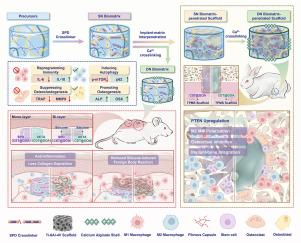Spermidine reduces peri-implant inflammation and fibrosis to nurture osseointegration
IF 18
1区 医学
Q1 ENGINEERING, BIOMEDICAL
引用次数: 0
Abstract
Medical implants of exogenous materials often induce foreign body response (FBR) in hosts, which is characterized by inflammation and fibrosis. Herein, composite scaffolds with interpenetrating hard and soft phases were fabricated, consisting of titanium alloy and a biomatrix mimicking extracellular matrix. Spermidine-functionalized biomatrix (CST@GOA) not only inhibits inflammatory response and osteoclastogenesis of macrophages, but also fosters migration and osteogenesis of MC3T3-E1 cells. Interestingly, CST@GOA can mitigate acute inflammation and fibrosis, characteristics of FBR, against silicone implanted in rats. Moreover, bone repair experiments in rabbits show that CST@GOA-interpenetrated porous titanium alloy scaffolds attenuate FBR against metal implants and promote osseointegration. Meanwhile, diethylenetriamine, a polyamine resembling spermidine in chemistry, has been used in place of spermidine to enable ‘operando’ comparison in both cell and animal experiments. Proteomic analysis of rabbit bone tissues reveals that spermidine modulates PI3K-Akt pathway by upregulating PTEN, which may play a pivotal role in coordinating downstream signaling of inflammation, autophagy and bone homeostasis. Together, it is demonstrated that spermidine can endow either synthetic polymers or metal implants with anti-FBR activity by regulating host response and nurture peri-implant niche to improve osseointegration of metal implants. Hence, spermidine affords a natural and elegant strategy to alleviate FBR against medical implants.

亚精胺减少种植体周围的炎症和纤维化,以促进骨整合
外源性材料医用植入物常在宿主体内诱发异体反应(foreign body response, FBR),其特征为炎症和纤维化。本文制备了由钛合金和模拟细胞外基质的生物基质组成的硬、软相互穿的复合支架。亚精胺功能化生物基质(CST@GOA)不仅能抑制巨噬细胞的炎症反应和破骨生成,还能促进MC3T3-E1细胞的迁移和成骨。有趣的是,CST@GOA可以减轻急性炎症和纤维化,这是FBR的特征,与硅胶植入大鼠相比。此外,兔骨修复实验表明CST@GOA-interpenetrated多孔钛合金支架可减弱对金属植入物的FBR,促进骨整合。与此同时,二乙烯三胺,一种在化学上类似亚精胺的多胺,已被用来代替亚精胺,在细胞和动物实验中进行“operando”比较。兔骨组织的蛋白质组学分析表明,亚精胺通过上调PTEN调控PI3K-Akt通路,可能在协调炎症、自噬和骨稳态的下游信号通路中发挥关键作用。综上所述,亚精胺可以通过调节宿主反应,赋予合成聚合物或金属种植体抗fbr活性,并培养种植体周围生态位,从而改善金属种植体的骨整合。因此,亚精胺提供了一种自然而优雅的策略来减轻对医疗植入物的FBR。
本文章由计算机程序翻译,如有差异,请以英文原文为准。
求助全文
约1分钟内获得全文
求助全文
来源期刊

Bioactive Materials
Biochemistry, Genetics and Molecular Biology-Biotechnology
CiteScore
28.00
自引率
6.30%
发文量
436
审稿时长
20 days
期刊介绍:
Bioactive Materials is a peer-reviewed research publication that focuses on advancements in bioactive materials. The journal accepts research papers, reviews, and rapid communications in the field of next-generation biomaterials that interact with cells, tissues, and organs in various living organisms.
The primary goal of Bioactive Materials is to promote the science and engineering of biomaterials that exhibit adaptiveness to the biological environment. These materials are specifically designed to stimulate or direct appropriate cell and tissue responses or regulate interactions with microorganisms.
The journal covers a wide range of bioactive materials, including those that are engineered or designed in terms of their physical form (e.g. particulate, fiber), topology (e.g. porosity, surface roughness), or dimensions (ranging from macro to nano-scales). Contributions are sought from the following categories of bioactive materials:
Bioactive metals and alloys
Bioactive inorganics: ceramics, glasses, and carbon-based materials
Bioactive polymers and gels
Bioactive materials derived from natural sources
Bioactive composites
These materials find applications in human and veterinary medicine, such as implants, tissue engineering scaffolds, cell/drug/gene carriers, as well as imaging and sensing devices.
 求助内容:
求助内容: 应助结果提醒方式:
应助结果提醒方式:


